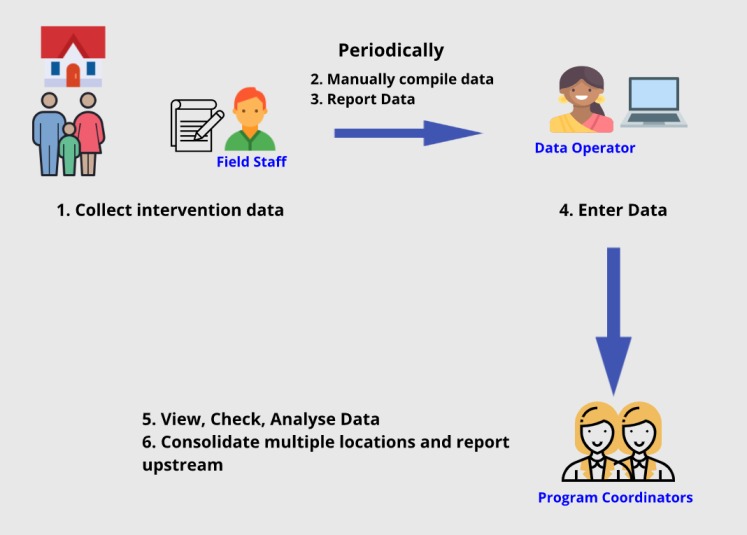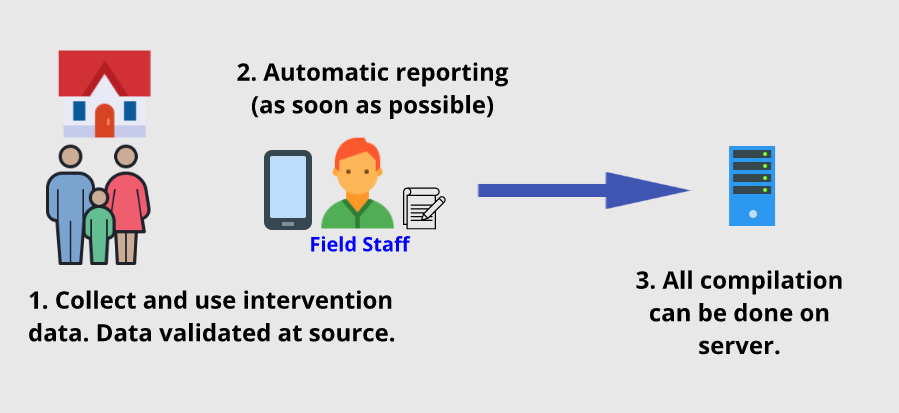Context
In most field programs there is a time lag between data collection and data reporting - since the reporting is expected only periodically. This collected data is compiled manually by the field staff at the end of the period and reported up in the hierarchy. There are two types of compilation - aggregation and data filtering. Some examples of aggregation done are calculating the number of new houses registered, the number of people tested positive for a disease, so on. These aggregate data elements to be reported periodically may run into dozens. When the reporting formats are at the intervention unit level - e.g. name, age, gender, caste, religion, APL/BPL status of the newly registered. Here the field staff is essentially reporting sub-set of the fields s/he has collected for each intervention unit.
 It is possible that the data entry is done by the field staff themselves at the end of the period
It is possible that the data entry is done by the field staff themselves at the end of the period
Reason for procrastination
While, the field teams in the social sector enjoy working with their communities, servicing community members, meeting their own program targets - but they do not particularly like entering data into an excel, paper, or a data entry system (aka MIS) - the way it happens. Hence, it is not uncommon that one of the tasks of program coordinators is to followup with field team about data submission - at the end of their reporting period. On the other hand, the funders and senior leaders do want to know about the exact impact being created - and data has become the primary evidence and communication tool. So, nonprofit projects/programs face these two opposing forces, looking for solutions.
Before we think about potential solutions to this, we must look deeper into the issue itself, by asking a very simple and obvious question - why does the field team dislike entering data in the first place? The answer is not very difficult to discover. Some of the common root causes are as follows:
- The data compilation and entry is monotonous work and time-consuming.
- The person performing above doesn't experience any benefit from it. As far as they are concerned the data compiled and submitted by them pretty much vanishes in ether, never to be heard about again.
- He/she is stressed about making mistakes while doing such work. This is not good to experience which people want to go through - hence one instinctively tries to procrastinate such types of work, as long as they can.
Our experience suggests that these issues are recognised by all level of field workers, not simply by the more skilled ones. Even community workers at village levels experience this, quite naturally. It’s just that in most cases, they hesitate in expressing their emotions (because of social hierarchy) - but upon genuine prodding in a safe-environment one can discover the same reasons at play, quite easily.
But if instead of empathising with these circumstances, if the organisation’s response is of economic reasoning, like:
- but funders need the data after all so what to do
- without funds, there would not be any fieldwork in first place
...then it creates a no-win situation and the status quo continues. Field team procrastinates, data is delayed, data is of poor quality, to cleanup data more time is spent - burning down everyone involved.
As we can see from our root cause analysis that procrastination and its direct effects present only half the picture. The harm and underlying missed opportunities it hides are far more serious issues for our programs - worthy of our attention.
Solution ideas
The root causes listed above themselves, point to the solution. In most cases, a "happier" system looks like the following.
- The data capture happening as part of the users’ workflow instead of being batched together in a separate activity, to be done later. The crux of the solution here is that 1 hour of data entry per day, gets broken down into 30 instances of 2 minutes each. These are for 30 clients which field worker is interacting with, on that day. The data capture work mixes and pleasantly disappears with other tasks one is doing (as elaborated here more).
- The software has functionality that has direct benefits for the field user - unlike a black box system in which fieldworker only adds data but never gets back anything useful. e.g. community health workers can view critical medical information of their client from their history; in agriculture, community resource person can provide information to their client which are generated by calculating based on previous data about land/inputs/micro-plan. A few other sample benefits are (there are many):
- Software system maintains users work schedule based on their client data.
- The software provides reports to the field user based on their work. e.g. the number of clients they have supported, outcomes achieved, and so on. This gives a sense of accomplishment which is highly important.
- The software aggressively validates data and performs computations for the user. One comes across numerous programs where the user is burdened with tasks that are much easier done by software. These software systems consider validation to be merely about mandatory, character size, number range etc. This is simply lack of imagination. The system can enforce much more useful validations like:
- The client cannot be born before the date of their registration
- A male client cannot be pregnant. A child cannot be older than his/her mother (or only 5 years younger).
- One cannot produce more than certain kilos of wheat from an acre plot size.
- This may not be possible everywhere, but if the software system can go even further such that in monthly meetings (which is a common practice), the fieldworkers can present their data using the software itself - it can have quite an empowering effect. We have seen it in a few places, this needs to be tried more.
We highly recommend doing 1 and 2, at a bare minimum. 3 is also important if you find yourself spending too much time in, what is referred to as a necessary activity, called "cleaning of data" or "validating data". In fact, these are unnecessary tasks and quite stressful because human beings are not good at these tasks.
In conclusion
The fundamental idea that transforms from the state of procrastination to involvement is to make the fieldworkers productive and involve them fully in the data system. Most importantly it will improve the quality of service provided to clients. Finally, the resulting data flow looks rather unimpressive in the diagram :-). We also recommend reading this article which covers issues around transitioning from paper to digital.

Author: Vivek Singh
Published: 22-October-2020
(Icons thanks to icons8)